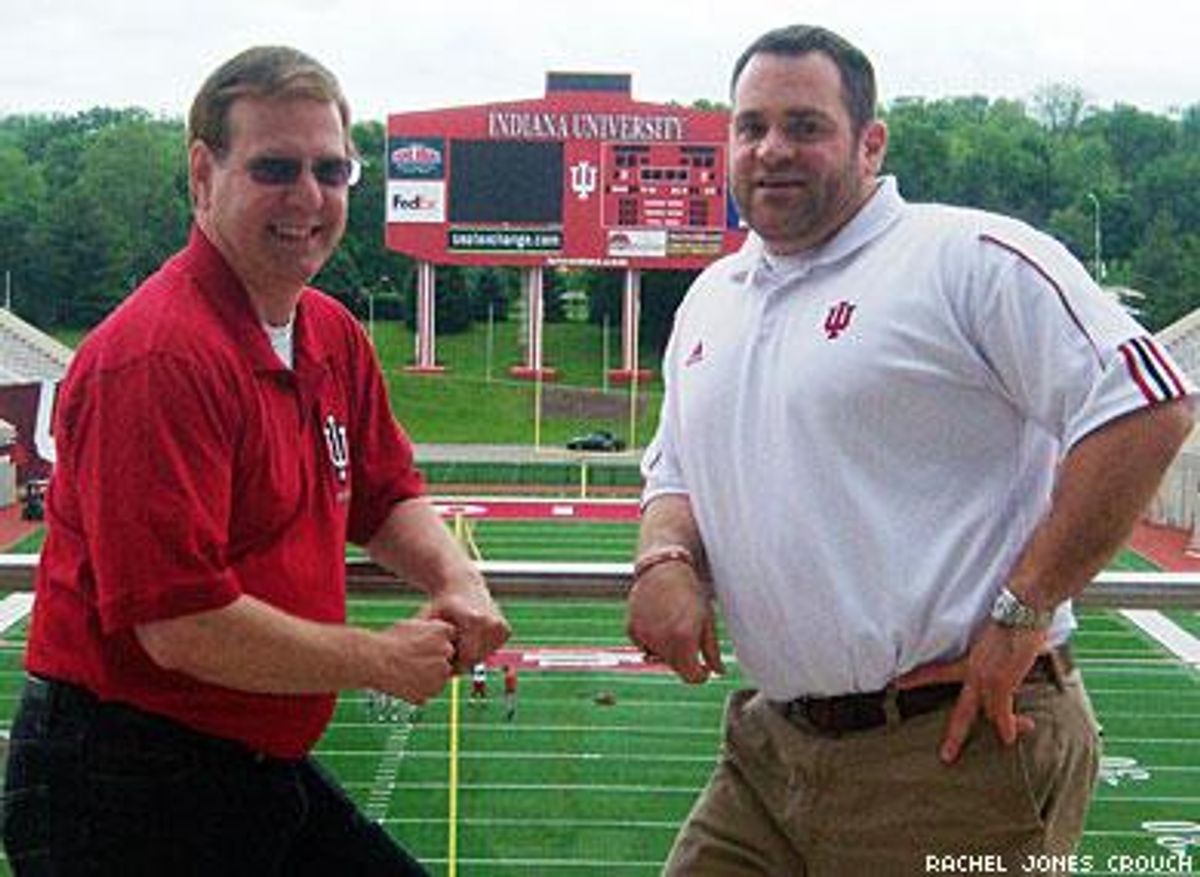People outside the Midwest often ask how to define a Hoosier, the official term for a resident of Indiana and the mascot for the Indiana University athletic teams. While the answer eludes all but the most devoted followers, recent actions by the school's athletic department indicate that sexual orientation is an irrelevant aspect. Athletics officials say that their top priority is to cultivate fans crazy about their dedication to the Big Ten school, period.
"It's someone who is passionate about Indiana athletics," said Pat Kraft, senior assistant athletic director for marketing. "I see what they're wearing and if they're Indiana, I'm all fired up. All I care about is that there are 56,000 people at our football game. Gay or straight, it doesn't matter as long as they're Indiana Hoosier fans and they're excited."
That game-day attitude prompted Kraft, a former Hoosiers linebacker, to agree to attend his first gay pride event and work a booth at the Indy Pride festival in Indianapolis on June 12. School officials believe the appearance will mark the first time an athletic department has participated in such a festival. According to those involved with the process, the arrangement shows what can happen when the LGBT and sports communities let go of their assumptions and stretch outside their comfort (end) zones.
Jon Kitto, secretary of the Indiana University Gay, Lesbian, Bisexual, and Transgender Alumni Association, says the breakthrough began last September, when he attended the dedication of a football facility and heard new athletic director Fred Glass say he wanted to reach out to different communities.
"He wasn't thinking about GLBT groups when he said that," said Kitto. "They weren't looking not to. It wasn't on top of anybody's list. We needed to ask."
As it happened, the window opened at a pivotal moment in the recent history of Indiana University's flagship campus in Bloomington, home to more than 40,000 students southwest of Indianapolis. Months earlier, controversy had erupted when the Kelley School of Business presented Marine Gen. Peter Pace, retired chairman of the Joint Chiefs of Staff, with a yearlong appointment. The general angered gay rights activists in 2007 when, during his tenure as the nation's highest-ranking military officer, he expressed his personal view that homosexuality is "immoral" and asserted his support for the "don't ask, don't tell" policy.
Given the bumpy episode, Kitto says he resolved to approach Glass and
the athletic department for a meeting last December with the goal of
fostering stronger ties between the gay community and other campus
departments. He had no idea what to expect.
"We in the LGBT
community generally have stereotypes about people in sports," said
Kitto. "The thing that floored me about all these people is that they
didn't care."
Support from the athletic department and the
football team in particular felt immediate and strong. The department
donated items to the silent auction for the LGBT homecoming, and the
football coached helped judge the Mr. Out at Kelley contest.
Kitto
felt comfortable asking Kraft about making an appearance at Indy Pride,
and Kraft responded affirmatively the next day.
Kraft and two
others, none of whom have ever attended a gay pride event, will staff
the Indiana University athletic department booth during the festival on
the same day as the parade. He said he looks forward to the experience.
"Like
I feel about all of our events, I'm excited," said Kraft. "Because it's
a new thing for us, I'm actually really excited. At the end of the day,
my job is to get Hoosier fans excited."
Officials say the
pride festival participation and other advances this year have marked
the start of a solid working relationship. In fact, they are already
talking about an outreach effort to gay youths on the day this fall when
area high school students attend an Indiana University football game.
No high-profile athletes have come out as gay yet, but as the
relationship continues to develop, that is likely only a matter of time.
Perhaps the person least surprised by all the progress is athletic
director Fred Glass, who mentioned the trailblazing history of Indiana
University as the home of the first African-American to play basketball
in the Big Ten, the first African-American to be drafted into the NFL,
and the Kinsey Institute.
"There's been no formal feedback, but I
can tell you that more than one trustee is aware of it and has told me
it's great and that is what Indiana University should be about," said
Glass, also a vice president of the school. "Indiana University has
always been on the cutting edge on acceptance and tolerance."
When
Glass, a former chief of staff for U.S. senator Evan Bayh, took the job
of athletic director in January 2009, he said that integrating the
department with the rest of the university became a top priority.
"In
a word, yes, I think there was still the perception and unfortunately
some reality that athletics was a silo comfortable doing its own things
and that everybody else could mind their own business," he said.
In
the end, the strategy appears to make for good business, smart politics,
and a stronger campus community.
"A lot of what I think our
business is, is making memories for all different kinds of people, said
Glass. "Today's young person is tomorrow's college student and the next
day's alumnus."
And always a Hoosier.

